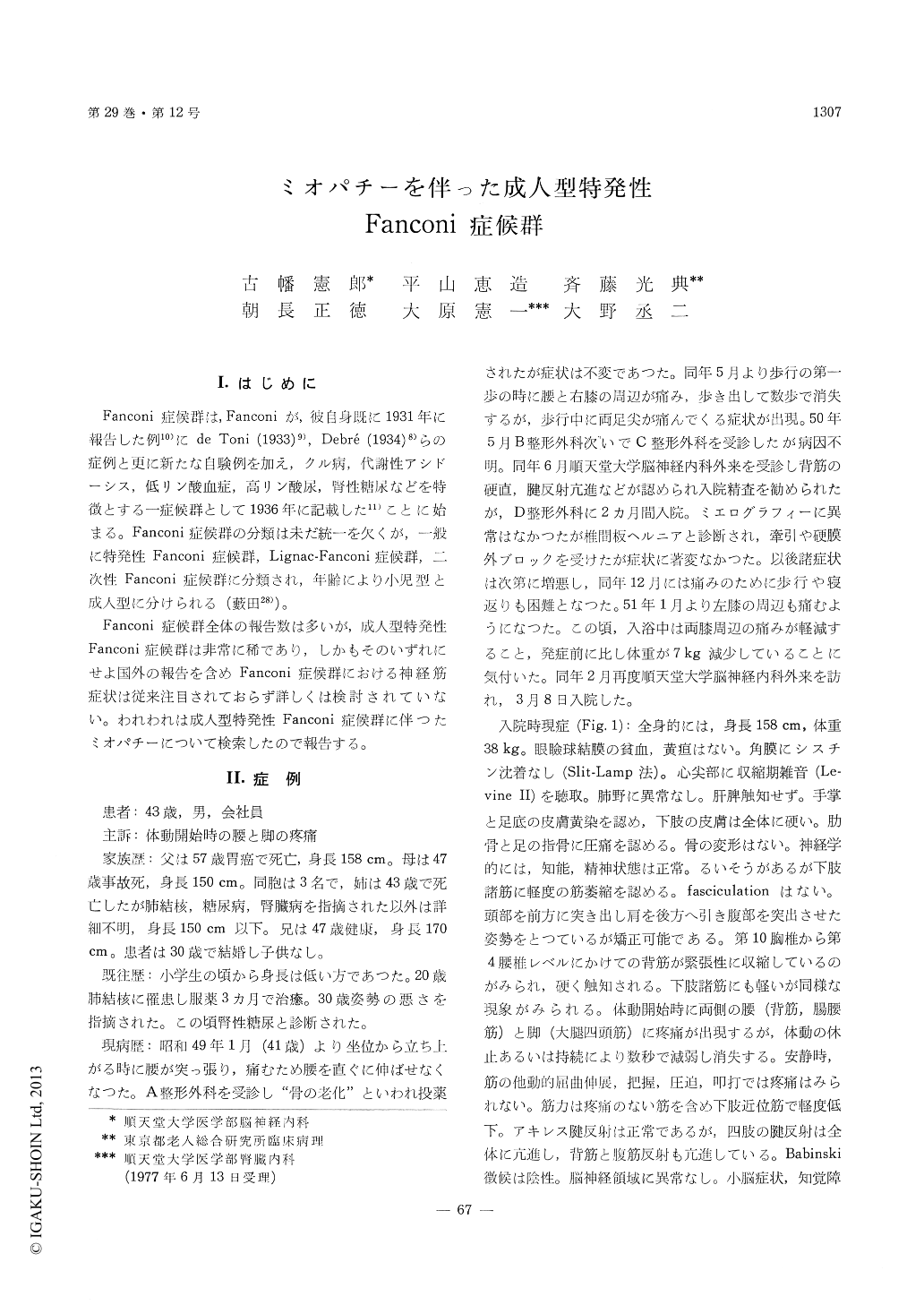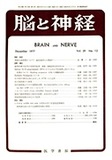Japanese
English
- 有料閲覧
- Abstract 文献概要
- 1ページ目 Look Inside
I.はじめに
Fanconi症候群は,Fanconiが,彼自身既に1931年に報告した例10)にde Toni (1933)19),Debré(1934)8)らの症例と更に新たな自験例を加え,クル病,代謝性アシドーシス,低リン酸血症,高リン酸尿,腎性糖尿などを特徴とする一症候群として1936年に記載した11)ことに始まる。Fanconi症候群の分類は未だ統一を欠くが,一般に特発性Fanconi症候群,Lignac-Fanconi症候群,二次性Fanconi症候群に分類され,年齢により小児型と成人型に分けられる(藪田28))。
Fanconi症候群全体の報告数は多いが,成人型特発性Fanconi症候群は非常に稀であり,しかもそのいずれにせよ国外の報告を含めFanconi症候群における神経筋症状は従来注目されておらず詳しくは検討されていない。われわれは成人型特発性Fanconi症候群に伴つたミオパチーについて検索したので報告する。
A rare case of adult idiopathic Fanconi syndrome with myopathy was reported. There is only a report of Mallette et al. (1977) about Fanconi syn-drome with neurological manifestation.
A 43-year old man (Fig. 1) began to experience muscular pain in the lower girdle and limbs on standing up since two years before admission. The muscular pain was relieved by taking hot bath.
He was short, being 158 cm in height and of 38 kg in weight at admission.
Physical examination revealed pressure pain in ribs and phalanges of feet. There was no cystine deposit in cornea by slit-lamp examination. He had pain of the lower back and iliopsoas and quadriceps femoris muscles only at initiation of movements. There was no pain on grasping or passive movement of these muscles. Tonic con-traction of these muscles was observable at rest. Slight muscular atrophy and weakness of lower limbs were noted, but there was no fasciculation. Tendon reflexes were generally hyperactive, but with no Babinski sign. No sensory change was noted.
Laboratory examination (Table 1) showed elevated serum alkaline phosphatase level, hypocalcemia, hypopotassemia, metabolic acidosis, albuminuria, renal glycosuria, aminoaciduria, creatinuria, and increase of phosphate clearance. Urinary acidi-fication in NH4CI loading test was normal. The serum creatine phosphokinase level was normal. X-ray examination revealed pseudofractures of the ribs and phalanges of the feet (Fig. 2). Iliac bone biopsy showed widening of csteoid seam. Diagnosis of Fanconi syndrome was confirmed by these ex-aminations.
Electromyography of the lower back muscles showed no activity at rest. No myopathic and neurogenic change of individual muscles was found. Jolly's test showed obvious waning phenomenon, though it was rapidly improved by intravenous calcium administration. Motor and sensory nerve conduction velocities were within normal.
A biopsy specimen from the quadriceps femoris muscle was examined histochemically and electron-microscopically. Marked variation of muscle fiber size and histochemically type II fiber atrophy and type I fiber hypertrophy were noted (Fig. 3). Moth-eaton change of type I fibers was present, though no grouped atrophy was noted (Fig. 4). However, a tendency to grouping of type I fibers was observed. On electron microscopy, Z band-streaming in many hypertrophic muscle fibers was noted (Fig. 5), and many atrophic muscle fibers had invagination of sarcolemma, widening of T-system (Fig. 6), in-creased lipopigment and thickening of basement membrane. The basement membrane of small
vessels was thickened (Fig. 7). Axonal degener-ation and protagon granules deposit of Schwann cell of the myelinated nerve fibers around the vein were noted (Fig. 8).
Myopathy in this case was improved by admin-istration of 1α-hydroxy vitamin D3, sodium bi-carbonate and Shohl's solution.
It was discussed that muscle change in this case might be caused by osteomalacia or hyperparathy-roidism of Fanconi syndrome.

Copyright © 1977, Igaku-Shoin Ltd. All rights reserved.


